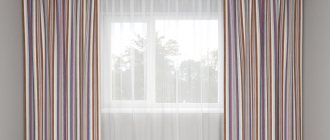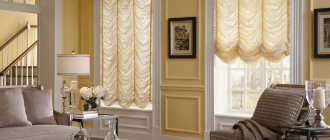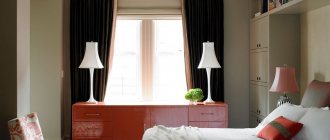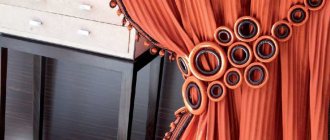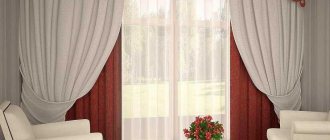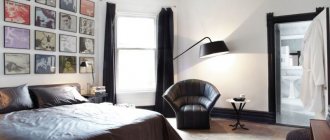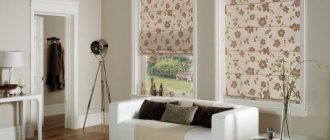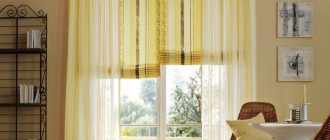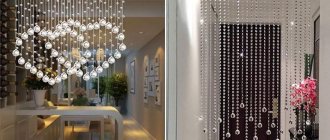French curtains, which first appeared in the 17th century under Louis the Thirteenth, belong to the category of curtains - light, fixed curtains on windows.
Features of French curtains are:
- placement along the entire height of the room - from ceiling to floor;
- the possibility of vertical lifting of the canvas for access to the window opening;
- dividing a single fabric with cords or ribbons into vertical stripes called scallops;
- the presence of freely flowing folds of material on festoons in the form of inverted arches along the entire height of the curtain;
- use in interiors decorated in classical and baroque styles.
Numerous modern sources assign the name “marquise” to the French curtain, drawing an analogy between the lush folds of the clothes of court ladies and similar folds of curtains on the windows. However, it is important to understand that there is no reliable information to support this statement.
Types of French curtains
They differ in several ways:
- stationary or lifting;
- single-festoon or multi-festoon;
- with manual, mechanical or electrical methods of lifting the web;
- short or long;
- outdoor or indoor placement.
Stationary
The traditional use of non-lifting canvases is in exhibition halls, art galleries, administrative and public buildings, where there is no need to regulate the flow of sunlight through the windows, and the necessary illumination is achieved by internal sources of artificial light. The main material of stationary French fabrics is white silk, translucent organza, light viscose.
eleonora_travertino
brianscottpittman
Lifting
They are used mainly in rooms where it is necessary to regulate the intensity of sunlight entering the room. For French lift-up curtains, colored translucent, opaque and light translucent fabrics are used. Placed on windows facing south and southeast.
designerihomeart
aura_home_com
assem_nurlybayeva
With one scallop
At first glance, this curtain can be mistaken for a Roman one, but the absence of a weight strip at the bottom and drawstrings fixed along the height of the canvas indicates that it belongs to the French type. The peculiarity of this type is the even fabric along the entire height and the formation of folds along the lower border due to the rise of the cords placed along the side edges of the curtain.
jade_creative
Multi-festoon
Their number is determined by the density of the fabric, the width of the window, the height of the room and the design of the curtain. The usual distances between vertical braid, cords or ribbons delimiting scallops are:
- 25 or 30 cm when using organza, fine linen or silk;
- up to 40 cm when using tulle, cotton, medium-density linen, satin;
- up to 50 cm when using velvet or plush.
An interior designer or decorator may not be guided by the indicated dimensions, creating lush folds of scallops with thin fabrics, depending on the intended purpose of the room.
brianscottpittman
bella.vita_perde
asperdeas
Manual lifting of the web
It is made using vertical tie-backs, secured together with the upper edge of the canvas above the window. The lifting height is adjusted by lifting the fabric to the desired height, tying tieback ribbons into knots and straightening the folds of the fabric. When lifting manually, two grabs are usually used, forming three festoons.
cindycountryhome
aura_home_com
Mechanical lift
It is carried out by winding vertical cords onto a single rod of the cornice, rotated using a chain mechanism. The ends of the cords, passed through vertical drawstrings in the form of opaque ribbons, are secured to the lower edge of the curtain fabric. When the cords are pulled, the fabric rises, gradually gathering from below into denser folds.
bella.vita_perde
perde_zaferoglu
Electric lift
It is used when there are a large number of festoons and a wide window opening, when the total weight of the fabrics does not allow the use of mechanical devices due to the long length of the cornice.
asperdeas
Short
They are used as a decorative element for decorating window openings or panoramic glazing on windows facing north or northeast. The fabric can cover the top third of the window, half or the entire window, extending down to the sill.
korona_perde
Regular length
The usual length of the canvas is from the cornice, where the upper edge of the fabric is fixed, to the floor. Fringes and decorations are not placed on the bottom border of these curtains. The material used is white or light cotton, viscose, satin or silk.
tamaradarg
annecahsens
perde_zaferoglu
Sliding
Despite the external resemblance to a traditional French curtain, this type is a canvas that can be moved to the side and attached to the ceiling cornice using plastic or metal hooks.
faikoglu_perde
asperdeas
LiveInternetLiveInternet
French folds are one of the most common types of top border design. Falling down and draped with tiebacks, the curtains form beautiful tails. The folds have different depths - from 7.5 to 20 cm.
And today we will start sewing curtains with French pleats
Necessary materials:
- decorative fabric
- lining fabric (optional)
- glued canvas 10 cm wide
- regular or decorative self-propelled cornice strip
- drapery weights
Curtains Worksheets
FABRIC WORKSHEET
Curtain length cm Desired length of the finished curtain …………………………….+ 20.5 cm for the top border ……………………………..+ 20.5 cm for 10 -centimeter hem seam……………………. + Length of the curtain cut = ……………………………………….. Width of the curtains Working length of the strip ……………………………………………………… + Allowance for two returns (protrusion of the strip from the wall plus 1.5 cm for each return) …………………………………….. + 9 cm for overlapping canvases ………………………………… + Width of finished curtains = …………………………………….. Total number of pieces of fabric in width The width of the finished curtain, multiplied by the fullness factor (2.5 - 3), divided by the width of the fabric ……………… …………. + Total number of fabric pieces by width, rounded to the nearest full width =…………………………….. Number of fabric pieces by width per curtain Total number of fabric pieces by width, divided by 2 ………… …… + Total number of pieces of fabric in width for each curtain =…………….
LINING FABRIC WORKSHEET
Fabric length cm Finished curtain length …………………………………… + 10 cm per 5 cm double bottom hem …………. + Lining cut length = ……………………………………. Number of pieces of fabric by width Calculate as for the total number of pieces of fabric by width (see above)
WORK SHEET OF FOLDS Used after completing paragraph 4 of these instructions to determine the number and size of folds and the distances between them. The recommended amount of fabric per fold is 10 to 15 cm. The recommended distance between folds is 9 to 10 cm. If the worksheet calculations result in more folds or spaces than the recommended number, add another fold or space. If the calculations result in a number that does not reach the recommended amount, subtract one fold or interval. Width of finished curtains cm Width of finished curtains (see calculations above), divided by 2 …………. + Width of the finished curtain = ……………………………………. Number of folds per curtain Number of pieces of fabric in width per curtain (see calculations above), …… x per number of folds per width * Number of folds per curtain = …………………………………. Distance between pleats Width of finished curtain (see calculations above) …………………… - Overlaps and returns (see above) ……………………………..= Width to be pleated. Divide it by the number of intervals per curtain (one less than the number of folds per curtain) Distance between folds = ……………………………………………………
FOLD SIZE
Width of the curtain with finished hemming seams (from point 4.) Width of the finished curtain (see calculations above) …………………… - Total number of fold allowances divided by the number of folds per curtain (see calculations above) … ……………………………. Fold size = …………………………………………. * Let's say that for a fabric with a width of 122 cm there are 5 folds, and for a fabric with a width of 137 cm - 6. Then, for example, a fabric with a width of 137 cm and three pieces of fabric across the width will have 18 folds. If we have pieces of fabric with half width, then 2 or 3 folds should be provided for this width.
ASSEMBLY SPACE
When taking measurements, you should not forget about the collection space (see issue “Winter 2003”), which will allow you to open the window without interference with the curtains open. The size of the gathering space depends on the weight of the fabric, the fullness of the curtains and whether they have a lining, but, as a rule, it is one third of the width of the window, divided equally between the two sides. Curtain rod and curtain length! If the curtains will be hung on a regular self-propelled strip, determine the length of the finished curtain by measuring the distance from the top of the curtain rod to the desired bottom edge of the curtain and add 1.3 cm so that the fabric is higher than the curtain rod. If the strip is decorative, measure the distance between the bottom of the strip and the desired bottom edge of the curtain. (We remind you that the classic, professional length of the curtain is no more than 1.5 cm from the floor). If you are using a curtain rod with rings, measure the distance from the holes of the rings to the bottom edge of the curtain.
COMPLETENESS
Most curtains use a two-half thickness, but for sheer fabrics it can be three times. For tulle curtains, a two-half fullness is used, which allows you to trace the pattern of the fabric in the finished product. Worksheet We create a worksheet, which is especially necessary for determining the number of folds, their size and the distance between them.
CUT
We create worksheets where we record all measurements (see below). Often several pieces of fabric are required across the width. We cut the required number of pieces of fabric in width in accordance with the calculated length of the curtains. If the number of pieces in width is an odd number, cut one of them in half lengthwise and sew each half to the left and right curtains.
MEASUREMENTS AND CALCULATIONS - GENERAL RECOMMENDATIONS
- Width: the full width of the panel should be 2.5 times the final width of the curtain (1 and 2).
- The length of the end section (c) and the overlap section (Y) is usually 7.5 cm. The areas between the folds (b) plus the end section (c) affect the final width of the curtain (g). Each section between folds (b) should be approximately 15 cm.
- First subtract c and d from the final width (g). Now calculate how many times b will fit into what is left.
- Now you know how many spaces there should be between the folds (b); add one more to find out the total number of folds (a). Now subtract the final width (g) from the total width (f) to calculate the excess fabric that will go into the pleats. Divide the result by the total number of pleats to calculate the size of one pleat(s).
- For example, if the final width of the curtain is 1.1 m, the length of the outer section (c) is 12 cm and the length of the overlap (Y) is 8 cm, then 90 cm will go to the spaces between the folds (b). This will provide enough space for six spaces (b) and seven folds (a).
- Keep in mind that the raw top edge (f) should be 2.5 times the final folded width fg), i.e. in our example (f) would be: 1.1 m x 2.5 = 2.75 m. From the result obtained, subtract (6 x b) + c + d - g = 1.1 m. 1.65 m remains. Divide this amount into seven folds, and you will get approximately 23.5 cm for each fold.
Sewing curtains with French pleats without lining fabric
1.If necessary, we sew pieces of fabric along the width, cutting off the edge so that the edges do not gather. We process the seam allowances with an overlock or zigzag. We iron the seams apart or press them “towards the walls”. We bend along the bottom edge and iron twice on the wrong side, 10 cm each. We lay a straight or hidden stitch for the hem.
2.Cut a strip of adhesive canvas equal in width to each curtain. Place the adhesive strip flush with the top edge of the curtain on its reverse side. We fold the top border and the glued canvas to the wrong side and iron it. Pin or baste.
3.Iron twice 4 cm on the sides, insert drapery weights into the side hems at a distance of 7.5 cm from the bottom edge.
4.We sew a straight or blind stitch, forming a double hem seam. We hem the top edge by hand. Determine the number and size of pleats and the distance between them, as described in the “Pleat Worksheet.”
5. Mark the return (a) and overlap (b) on the left curtain with chalk.
We mark folds (c) and intervals (c) so that one fold is adjacent to the return, and the other is adjacent to the overlap. The seams should fall on the right boundaries of the intervals. The size of the folds may vary slightly and can be adjusted to the above condition within each piece of fabric. The intervals must be equal. Having folded the two curtains with their right sides together, we transfer the marks to the right curtain. 6. We form folds by matching the fold lines. We pin them with pins. Bend[/td]
| 7.We sew a fold line from the top edge of the top border to the bottom edge of the laminated canvas. For strength, we also add a reverse stitch. !!! The base line of the fold should be approximately 12mm above the base line of the top of the seal |
| 8.Check the width of the finished curtain along the top edge. If necessary, change the size of several folds to achieve the required curtain width. |
| 9.We divide each fold into three equal new folds. Press the edges of the new folds with your fingers. |
| 10.Press the center fold so that it touches the seam. We bend the folds formed on the sides. |
11. Press the outer folds to the central one. We squeeze all three folds together with our fingers, making sure that they are the same. We baste the folds with a sewing machine just above the bottom edge of the glued canvas, or we baste the folds by hand with fastening stitches using a large thimble.
12.We insert drapery hooks so that they are on each fold and at each edge of the curtain. On a conventional self-propelled bar (a), the top of the hook is 4.5 cm below the top edge of the border or 3.2 cm above the bottom edge of the border. On the decorative self-propelled strip (b), the top of the hook is 2 to 2.5 cm below the top edge of the border. On a ring cornice (c) the top of the hook is 6mm below the top edge of the border.
13.We bend the glued canvas in the middle between each pair of folds. We bend them forward if a regular self-propelled strip is used, or to the reverse side if a decorative self-propelled strip is used. After this operation, iron the folds with a warm, dry iron.
| 14.We thread the end hook on the return into the hole on the side of the bracket (a). We thread the hook of the first fold into the hole at the front corner of the bracket (b). |
| 15.We thread the hooks on the middle folds into the corresponding sliders. Excess sliders must be removed. We pass the hook for the last fold into the first hole of the main slider (a). We thread the last hook on the curtain overlap into the last hole of the main slider (b). We bend the hooks on the main slider so that they do not touch the fabric when opening the curtains. If necessary, move the front main slider forward. |
16.Open the curtains completely. Check the top border to make sure the glued canvas is folded. Starting from the top border, we straighten the curtain into soft, even folds of equal depth. To keep the folds perpendicular to the floor, they should be smoothed along the grain.
17.We staple a narrow strip of fabric around the curtain in the middle. Attach the second strip of fabric at the level of the bottom hem seam. Make sure the folds hang straight. To secure the folds, leave the curtains in this position for two weeks. If there is high humidity, one week is enough. between the top hem and the bottom hem. This strip will hold the folds in place. Don't squeeze them too hard - you might dent them.
Sewing curtains with French pleats and lining
| 1.We sew the drapery fabric as described above. If necessary, we sew pieces of lining fabric along the width, cutting off the edge. We process the seam allowances with an overlock or zigzag. We fold along the bottom edge and iron twice on the wrong side, 5 cm each. We sew a straight or blind stitch, forming a hem seam. |
| 2.Place the drapery fabric on a large surface. Place the lining on the drapery fabric, right sides together, so that the bottom edge of the lining is 8 inches above the bottom edge of the curtain. The raw side edges should match. |
| 3.Draw a line on the lining 20.5 cm from the top edge along the drapery fabric. Cut along the marked line. |
4.Cut a strip of adhesive canvas equal to the width of each banner. Place the adhesive canvas flush with the top edge of the curtain on its reverse side. We fold the top border and the adhesive canvas to the wrong side and iron it.
5.We fold it again, wrapping the adhesive canvas in fabric, and iron it. The edge of the lining will be flush with the edge of the top border. Pin or baste.
6.Iron twice 3.8 cm on the (-/.. sides, folding the lining and drapery fabric as one. Insert drapery weights into the side hems at a distance of 7.5 cm from the bottom edge.
7.We sew a straight or blind stitch, forming a double hem seam. We sew a hem seam on the top edge by hand.
8.We finish making the curtains as described above. Source
See also:
We sew the curtains with eyelets ourselves
If the curtain fabric is too long
“American” - seam for light transparent fabric
Where will they look good?
Modern designers use this type of window drapery in exceptional cases that meet customer requests for the design of elegant and exquisitely luxurious interiors.
Do you want to hang French curtains in your home?
No. Regular tulle on hooks looks good. I don't know. Most likely it is very expensive Yes. I like these curtains. I'll try them if I see them at my friends' houses and hear their reviews. I already have them.
In the kitchen
Small kitchen windows are rarely decorated with French curtains. They are difficult to maintain and not practical enough in conditions of high humidity and temperature changes. The appearance of such curtains in the kitchen indicates the desire of its owner to add an elegant and picturesque touch to the everyday routine.
bella.vita_perde
bella.vita_perde
aura_home_com
asperdeas
perde_zaferoglu
In the dining-living room
Large dining rooms with wide window openings, combined with a guest area and facing south, are decorated with large French curtains to add lively variety to the boring lines of furniture with two-tone interior decoration. Whimsical shadows cast by the folds of curtains create positive emotions, uplifting your mood.
asperdeas
bella.vita_perde
In the living room
Any living room interior with baroque style furniture requires the presence of French curtains on the windows. Only they are able to support the picturesque lines of the legs, backs and armrests of chairs, and the side curves of flat surfaces of tables, creating an atmosphere of historical sophistication in the room.
bella.vita_perde
In the bedroom
Designers pay little attention to French curtains in recreation areas, undeservedly considering them only ceremonial and ceremonial curtains. The smooth lines of the numerous folds of these canvases evoke positive emotions, relieve tension, and allow you to relax, enjoying a night's rest. Translucent fabrics of dark shades made of organza, linen or cotton can do this.
shanelmor_vilonot
In the office
The presence of these curtains in business offices has been considered traditional since the thirties of the twentieth century. Lush French linens made of white silk neutralized the boring lines of wall panels and furniture, compensated for the correct geometry of the rows of parquet planks, creating a festive atmosphere in the rooms.
Modern offices and offices have a pragmatic focus on creating a business atmosphere, which is why they do not have French curtains. Only the classic style of interior decoration allows their use.
bella.vita_perde
shanelmor_vilonot
aura_home_com
On the stairs
A rare case of placing double-festoon curtains on narrow windows of a flight of stairs in a private house, caused by the need to connect two similar types of room decoration on adjacent floors.
Exit to the balcony
The peculiarity of curtains to look beautiful on panoramic glazing and window openings of different heights explains their use for decorating exits to balconies. For example, a white or light canvas in combination with black vertical drawstrings and bells, emphasizing the two-color severity of the interior, dilutes the monotony of the finish with airy waves of fabric and a solemn appearance.
orhanlar_perde
asperdeas
Features of the interior style
There are a lot of options for making curtains in the French style, and to successfully complement the interior and avoid contradictions, you need to think through special details.
By adding romantic bows, you can create the perfect option for a girl’s nursery.
Austrian curtains - the best models with interesting tailoring options in the interior + 150 photos- Sheer curtains are an option that will help keep the interior light and cozy +140 photos
Art curtains - 125 photos of modern curtains with exceptional interior design!
In the kitchen, stripes in the color of the interior details, along the length of the curtain or along the bottom edge can be an excellent addition.
Curtains in the bedroom can be diluted with a thick, strict curtain.
A Provence style interior will be perfectly complemented by a French curtain with ruffles along the bottom edge.
French curtains can even be used to decorate a high-tech interior using wide awning tape or fabric with a metallic sheen
Advantages and disadvantages
Positive traits:
- beneficial effect on a person’s psychological state;
- Possibility of use with panoramic glazing, on windows of any width and height;
- compatibility with any types of curtains and lambrequins;
- the ability to smoothly adjust the intensity of interior lighting;
- universality of use in any premises of residential, administrative and public buildings.
Minuses:
- high manufacturing costs associated with the use of qualified specialists;
- difficulty of maintenance - washing, drying and ironing;
- It is problematic to modify curtains if they need to be used on another window.
Curtains with eyelets
Decorating the living room with eyelet curtains. 140 photo ideas for large and small, dark and light rooms
Look
More details
Filament curtains
Kitchen zoning and window decoration with 50 photos of solutions
Look
More details
Roller blinds
Selection of roller blinds for the interior of the kitchen, balcony, nursery, living room and bedroom. 50 photos
Look
More details
Roman curtains
How to decorate a balcony, living room and office with Roman blinds. 192 photos of different ideas
Look
More details
How to calculate the amount of fabric
Measure the window, more precisely the part (or more) of it that the curtain will cover.
Multiply the width by 1.5 (if you want a deeper ruffle than the standard one, you may need more fabric). As a rule, the length of the fabric laid is twice the height of the curtain.
blockquote>Calculate the number of festoons to know the amount of awning tape required. The step for a small window is from 25 to 30 cm, for a large wide one - from 50 to 60 cm. The tape will also gather in the process, so it is important to take it with a reserve.
Operating principles of cornices
Cornices for French curtains come in several types:
- open type;
- closed type;
- with chain drive;
- with cord drive;
- with electric drive.
Construction and operation of open cornices
The cornice body is attached to the wall or ceiling through additional brackets. Carriages with blocks for winding cords are attached to the lower part of the body. A square-section metal rod passes through the holes in the blocks of all carriages, the ends of which are fixed in the final bushing and the chain drive bushing. To raise the canvas, you need to pull the chain with a weight attached to the bottom. The chain rotates the chain drive bushing and the rod attached to it. Rotation is transmitted through the bar to carriages and blocks. When the blocks rotate, the cords are wound and retracted, and, as a result, the curtain fabric rises and lowers.
Open cornice
Construction and operation of closed cornices
The device is a cassette made of aluminum or plastic profile with end caps, which is attached to the wall or ceiling using additional brackets. Inside the cassette there is a metal rod with cord winding drums attached to it with screws. The ends of the rod are secured in an end cap on one side and in a chain-driven bushing on the other side of the cassette.
To raise or lower the curtain, you need to pull the chain, which rotates the chain mechanism bushing and the cassette rod.
Closed cornice
Construction and operation of curtain rods with cord drive
The device is a housing made of a metal or plastic profile, mounted on a wall or ceiling. Brackets with cords passed through them are inserted into the lower longitudinal slot of the profile. Some ends of the cords, passed through the vertical drawstrings on the curtain, are fixed to the lower edge of the canvas, the other ends, passing through the holes in the brackets, are collected into a single bundle of cords in the block. The movement of the bundle of cords under the influence of the weight of the curtain is restrained by a limiter that regulates the amount of rise and fall of the curtain fabric.
Curtain rod with cord drive
History of awning curtains
French curtains originated in the era of King Louis XIV. The Sun King loved luxury. Lush halls, graceful curves of furniture, large windows testified to pomp.
All these delights could not but affect the design of window openings. In ball rooms, windows began to be decorated with curtains made of natural silk. Their main feature was the abundance of lace.
The fashion for awning curtains spread throughout Europe. And now these luxurious curtains are used to decorate both rooms in the Rococo and Baroque styles, as well as rooms in the minimalist and Provence style.
Selection and calculation of fabric
The master class below shows how to sew a French curtain. The window size in the example above is 100 by 170 centimeters. Where 100 is the width of the window, and 170 is the height.
A window curtain with these dimensions should be 120 by 150 centimeters. Let's calculate the required amount of fabric for sewing as follows:
- width: 120 x 1.5=180 cm;
- height: 150 x 2=300 cm.
But that is not all. Since our curtain is planned on a drawstring, we need to add another 15 centimeters to the width of the calculated cut. So we get a width equal to 195 centimeters.
If you make a curtain with gathering tape, then there is no need to add these 15 centimeters.
We calculated the fabric this way, because our curtain will be assembled according to the “awning” principle.
An awning is a French curtain made from a single fabric - a scallop, which is assembled into lush folds.
We will make 2 scallops on our window. You can determine their number yourself based on the width of the window opening and your desire.
In this example there will be 2 scallops, so we will make 3 drawstrings: 2 on the sides and 1 in the center. For a wider window (if you plan 3 or 4 scallops) the number of central curtains will increase proportionally.
As for the texture and quality of the fabric, it is better to choose a light translucent one so that the curtain fits beautifully in the folds, is light and lets in a little light.
Awning curtain design
If you choose the right design, you can make the windows in each room unique.
Flowers and vegetation
A colorful floral print will give the interior a special mood and fill the room with energy. Such curtains will look good in rooms filled with sun.
Monograms
This ornament will satisfy even the most refined taste. With the help of monograms, a simple room turns into a royal apartment.
